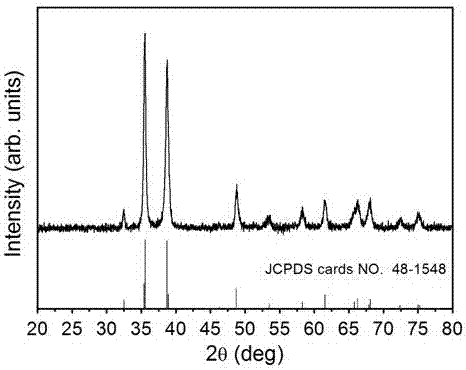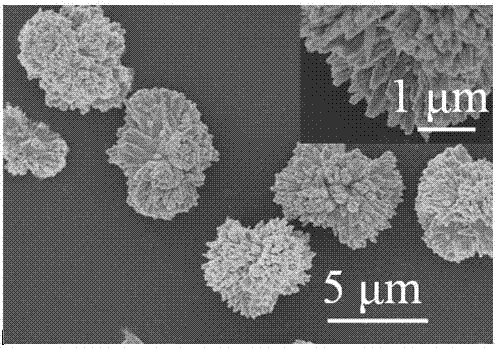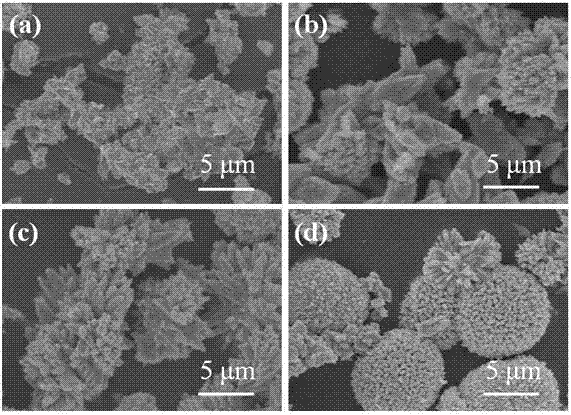Method for preparing flower-shaped CuO microsphere and application of flower-shaped CuO microsphere in formaldehyde gas sensor
A sensor and microsphere technology, applied in the field of preparation of CuO microspheres, can solve problems such as large-scale application and expensive detection equipment, and achieve good response-recovery characteristics and selectivity, good crystallization, and good dispersion
- Summary
- Abstract
- Description
- Claims
- Application Information
AI Technical Summary
Problems solved by technology
Method used
Image
Examples
preparation example Construction
[0023] (1) The preparation method of the flower-shaped CuO microspheres comprises the following steps:
[0024] Step 1: A certain amount of Cu(NO 3 ) 2 •3H 2 O, urea, and PEG20000 were dissolved in 80 mL of deionized water. Stir magnetically at room temperature for 30 minutes, and prepare a hydrothermal synthesis precursor reaction solution.
[0025] Step 2: Transfer the precursor reaction solution prepared in Step 1 into a polytetrafluoroethylene-lined stainless steel autoclave with a filling degree of 80% and seal it. Keep the temperature at 120-200°C for 12 hours, then cool down to room temperature with the furnace to obtain the reaction product.
[0026] Step 3: The reaction product obtained in Step 2 is centrifuged, washed repeatedly with distilled water and absolute ethanol, and then dried.
[0027] Step 4: Put the dried product in Step 3 into a muffle furnace and calcinate at 400° C. for 3 hours to obtain flower-shaped CuO microspheres.
[0028] (2) The steps of p...
Embodiment 1
[0034] (1) Preparation of flower-like CuO microspheres:
[0035] Step 1: 0.483 g Cu(NO 3 ) 2 ·3H 2 O, 0.36 g of urea, and 1.784 g of PEG20000 were dissolved in 80 mL of deionized water, and magnetically stirred at room temperature for 30 minutes to prepare a reaction solution of the precursor for hydrothermal synthesis.
[0036] Step 2: Transfer the precursor reaction solution prepared in Step 1 into a polytetrafluoroethylene-lined stainless steel autoclave with a filling degree of 80%, and seal it.
[0037] Step 3: Put the reaction kettle in Step 2 in an oven, keep it warm at 180° C. for 12 hours, and then cool it down.
[0038] Step 4: Centrifuge the reactant solution prepared in Step 3 to obtain a black precipitate, which is then repeatedly washed with distilled water and absolute ethanol.
[0039] Step 5: Place the product of Step 4 in a drying oven at a constant temperature at 80° C. for 24 hours for drying.
[0040] Step 6: Put the dried product in step 5 into a cle...
Embodiment 2
[0045] (1) Preparation of flower-like CuO microspheres:
[0046] Step one, two are with embodiment 1.
[0047] Step 3: Place the reaction kettle in Step 2 in an oven, keep it warm at 120° C. for 12 hours, and then cool it down.
[0048] Steps 4, 5 and 6 are the same as in Example 1.
[0049] (2) Structural characterization of flower-like CuO microspheres
[0050] The morphology of the product was characterized by scanning electron microscopy. Such as image 3 As shown in (a), the product is a bulk material composed of nanoblocks.
PUM
| Property | Measurement | Unit |
|---|---|---|
| diameter | aaaaa | aaaaa |
| diameter | aaaaa | aaaaa |
Abstract
Description
Claims
Application Information
 Login to View More
Login to View More - R&D Engineer
- R&D Manager
- IP Professional
- Industry Leading Data Capabilities
- Powerful AI technology
- Patent DNA Extraction
Browse by: Latest US Patents, China's latest patents, Technical Efficacy Thesaurus, Application Domain, Technology Topic, Popular Technical Reports.
© 2024 PatSnap. All rights reserved.Legal|Privacy policy|Modern Slavery Act Transparency Statement|Sitemap|About US| Contact US: help@patsnap.com










